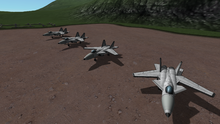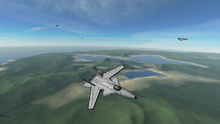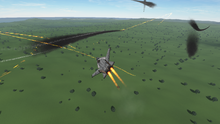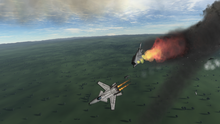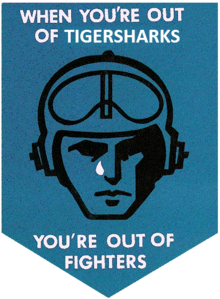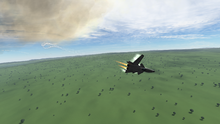Type 82 Kaminari
|
Asagiro-Losos Type 82 Kaminari
|
|||||
|---|---|---|---|---|---|
| Multirole Fighter | |||||
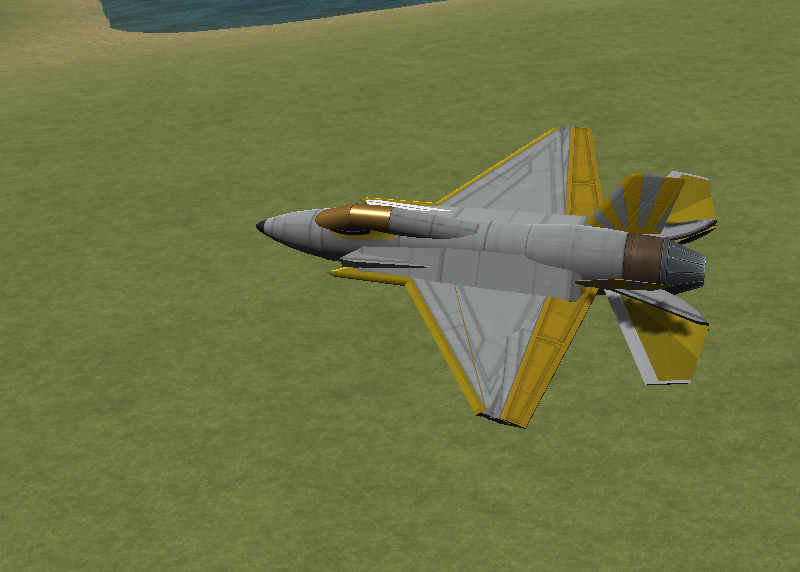 |
|||||
| A SRCAF Type 82 in flight over the southern Crytilian coast | |||||
| National Origin | Semuyic Republic of Crytil | ||||
| Production History | |||||
| Designed | |||||
| 2142 - 2145 | |||||
| Produced | |||||
| 2145 - Present | |||||
| Designer | Asagiro-Losos United | ||||
| Unit Cost | IDK LOL(√) | ||||
| Number Built | 200+ | ||||
| Service History | |||||
| In Service | |||||
| 2145 - Present | |||||
| Used By | Semuyic Republic of Crytil Air Force Zokesian Air Force United Imperial Federation Air Force Eurekan Defense Force Arvene Air Force Republic of Fortis Air Force | ||||
| Aircraft Characteristics | |||||
| Dry Mass | [mass] | ||||
| Length | 10.3 m | ||||
| Width | 8.4 m | ||||
| Height | 1.9 m | ||||
| Propulsion | [engine types and quantity] | ||||
| Operational Range | [range in km] km | ||||
| Crew | 1 | ||||
| Sensor Systems | [sensor types] | ||||
| Armament | [ship based arms] | ||||
| Variants | [aircraft variant names] | ||||
The Asagiro-Losos Type 82 Kaminari is a Crytilian family of single-seat, single-engine, stealth multirole combat aircraft capable of performing both air superiority and strike missions. The Kaminari was a joint venture between the two largest Aerospace firms in Crytil: Asagiro and Losos. It has gone through several upgrades and iterations throughout its service and a VTOL variant was developed by the Eurekan Defense Forces. The Kaminari airframe is highly modular and can be fitted with a variety of equipment to perform roles such as electronic warfare, reconnaissance, and close air support.
Development of the Kaminari began in response to lessons learned early on in the Burr War. The primary fighter at the time, the Type 65 Hagetaka performed admiraly against the Zalkent and Kathernian Air Forces, but was found to be lacking in combat against advanced foreign designs such as the Elohim AS-49. After years of flight testing and development, the aircraft formally entered service in 2080 as the F-74A and F-74S. Once operational, the Tigershark became critical to Tau Coalition air power during the Second Continental War, and later earned international notoriety for its success in the Greater Kerbin War. Presently, the Tigershark holds a legendary record of over 700 air victories with a 14-1 kill-loss ratio, cementing its position as one of the most infamous and successful fighter aircraft in Kerbal history, and earning the affectionate phrase from its operators "When you're out of Tigersharks, you're out of fighters."
Development
The Advanced Tactical Fighter (ATF) fighter program was initiated in 2073, in order for the Aeserian Air Force to explore potential next-generation replacements for its fleet of F-73F Super Cobra fighters, for the role of air superiority missions in frontline combat and long-range sorties. Despite the success and utility of the airframe, limitations on fuel capacity hindered its ability for deep strike operations without excess refueling, pilot criticism on aircraft stability, plus cost and maintenance issues from ground crews resulted in an investigation for a replacement design. Development emphasis on the ATF program prioritized an airframe which could maintain absolute air supremacy over extended regions at long range, increased stability without compromising the previous design's dogfighting prowess, and a streamlined maintenance chain for lower unit cost.
Cyten Aerospace Industries was awarded the ATF contract in early 2074. Over the course of the project's research and design phase, Cyten would be provided with priceless flight and combat data gathered by the Tau Coalition during the First Continental War; information obtained from first-hand experience fighting Arcadian designs proved invaluable to further propel the ATF initiative. Despite a prolonged development phase to perfect aircraft specifications, four YF-74s were constructed and the first test flights took place in 2077. Covert air combat testing against Aenian and Zokesian aggressor squadrons confirmed that, even in the experiemental phase, the YF-74 already was a capabale airframe, which earned upwards of 3-1 kill-loss ratios against similar Tau Coalition aircraft in simulated dogfights. Practical air combat testing further matured the design, and by 2080 the F-74A received the official designation "Tigershark" and low-rate initial production began, with contracts immediately received for the Aenian and Amberian Air Forces.
Design
"The YF-74 has been built from the ground up to be the foremost air superiority fighter of the free world... [the Tigershark] is the unstoppable force and the immovable object." ~Marcus Cyten, CEO of Cyten Aerospace Industries
The F-74 Tigershark is a fifth-generation fighter, and is the first Aenian aircraft to combine supercruise, hypermaneuverability, and sensor fusion within a single combat aircraft. Key avionics include the AN/APG-69 active electronically scanned array (AESA) radar in the nose, AN/ALQ-131 electronic countermeasure suite in the tail, and computerized flight control and digital stability systems situated behind the cockpit. In total, the F-74's avionics software has some 1.7 million lines of code, providing the aircraft with Beyond Visual Range (BVR) lethality and improved pilot handling.
The F-74 has high agility at subsonic speeds, enabling angle-of-attack and flight path alteration quickly, while retaining maneuverability and energy in supersonic flight. The forward-swept wing gives the Tigershark its unique appearance, and yields the airframe with a number of advantages--improved stall and spin resistance, higher lift-drag ratio, and lower minimum flight speed grant the Tigershark exceptional performance in close-in air-to-air combat. The F-74 benefits from STOL capability and improved range at subsonic speed, to accommodate a wide variety of air operations.
The aircraft's dual J-404 engines incorporate 3D thrust-vectoring nozzles, with a thrust to weight ratio of 1.1 at typical combat configuration and maximum power, and a classified value for full afterburner, speculated to be near 1.5. The F-74 is among the few combat aircraft that can supercruise, or sustain supersonic flight without afterburners, which vastly increases the aircraft's intercept capabilities and long-range fuel efficiency.
The Tigershark's aerodynamics, stability, and thrust-vectoring engines enable the aircraft to turn tightly and execute post-stall maneuvers, such as the Herbst J-turn and Pugachev's Cobra. Although not a full stealth aircraft, the F-74 was designed for a reduced radar cross-section (RCS), minimizing radar signature at long distances. Employing its advantages, a Tigershark pilot can effectively attack targets in BVR combat without compromising survivability, and can utilize the extent of the F-74's agility for unrivaled dogfighting capability.
Operational History
Introduction and Early Service
The Tigersharks first entered low-rate initial production in early 2080, under the variant 'F-74A;' the first batches of aircraft were delivered by contracts to the air forces of Aenia and Amber. A total of 36 F-74As would be put into service in the FCA by the end of the year, retiring its fleet of land-based variants of the preceding F-73Fs, within the Aenian Air Force's divisions of Tactical Fighter Wings. 24 F-74As would similarly be delivered to the Republic of Amber, and incorporated into their fighter command.
The F-74 would first see combat during the Liberation of Kanbek in 2080, where the Amber Republic Air Force strike packages into the neighboring communist state would be spearheaded by Tigershark elements. With a minimal air defense force, of only two dozen aircraft and assorted domestic missile sites, the Amberian Tigersharks only scored a few kills in Operation Varsity's air campaign, though the F-74 squadrons would continue Combat Air Patrols as ARAF Condor sorties provided close-air support to advancing armor columns.
Though not a spectacular demonstration of air-to-air prowess, the Tigershark's performance in Operation Varsity proved the efficiency of the design compared to its predecessor, with a vastly improved combat readiness and sortie rates against the F-73F. ARAF pilots with fresh first-hand combat experience flying the aircraft contributed input to improvements in the airframe, leading to the design of an updated variant with increased engine performance and airframe rigidity designated the 'F-74S.' In the following months, the existing A-variants would be updated and more aircraft would be produced, and a combined total of 100 F-74S's would be declared combat operational by Aenia and Amber by the end of 2080 as the countries mobilized at the end of the 2077-2080 Cold War with Doren.
Second Continental War
At the beginning of the Second Continental War in early January 2081, several Aenian fighter wings received orders to begin long-range air incursions into western Doren. Aenian assets involved in the first strike included the Tactical Fighter Wings of the 6th and 9th Air Divisions, totaling to forty Tigersharks providing air escort to forty F-51SE 'Silent Garuda' strike fighters on interdiction sorties. In a prolonged air campaign called 'Operation Blackout,' they were immediately engaged by multiple waves of defending Doren aircraft, redirected from their initial missions of reinforcing the Konig Air War in order to intercept the incoming strike packages.
When it became apparent to the AAF's airborne command and control centers that the defending CPD aircraft had a significant numerical superiority in the Sintrier air region, it was feared that the strike packages would be overwhelmed by intense swarm attacks. However, the Tigershark crews were able to more than make up for numbers--several CPD 'Wyverns' would consistently be lost in BVR combat from volleys of long-range missiles, turning the tide of each air engagement into the FCA's favor. With Garuda elements delivering their air-to-ground ordinance on enemy SAM sites, and radar networks, the F-74s were critical to the acquisition of air supremacy over the continent.
By 0400 hours, the skies over Sintrier fell silent, as the last of the defending Wyverns were shot down in air combat by patrolling flights of Tigersharks, and Dorenian reinforcements stopped trickling in. Initially considered a pause in the air campaign, it became clear to radar operators from the Aenian AWACS's operating in the area that the airspace has been sanitized of all opposition--absolute air supremacy over west Doren had been achieved. Miraculously, not a single fighter was lost in air combat; over a 100 Dorenian fighters were shot down by escort F-74s without any casualties. Due to the combat prowess of the Tigersharks, the Tau Coalition strike packages were all still at full strength, and successfully struck critical military targets with impunity, shifting the tide of the Western Front decisively in NEOCON's favor.
Greater Kerbin War
After their successes in the 2081 war against Doren, the Tigershark would receive international notoriety for its role in maintaining air superiority over the Greater Kerbin Union (previously Aenia and Amber) in the 2083 Greater Kerbin War. GKU Air Command initiated Operation Shadow Realm as over 1,200 enemy fighters, from seven different nations, converged over continental airspace with the objective of achieving air supremacy amidst the MCS asteroid bombardment of the region. Every aircraft within the GKU arsenal capable of air-to-air combat was commanded for an emergency scramble, under standing orders to intercept and eliminate any unidentified or enemy aircraft in allied air corridors. including the 120 total Tigersharks across the GKU's air divisions, fighting alongside hundreds of other allied fighters.
Utilizing the experience fighting swarms of drone fighters obtained from the previous conflict, the F-74s would prove paramount to the air defense , as the initial GKU flights of scrambled squadrons found themselves desperately outnumbered by attacking Dragon aircraft. Despite comprising roughly a quarter of all scrambled aircraft in the first wave of defense, the GKU's fleet of Tigersharks accounted for roughly half of the enemy Dragons and K-126s shot down over Airspace B7R in the opening hours of the air war. With ground-based radar sites taken out by kinetic bombradment and allied Airborne Early Warning crews overwhelmed by sheer numbers, F-74 wings utilized their powerful AESA radars for the 'Mini-AWACS' role in order to direct flights of Condor and Crusader light fighters towards incoming strike packages. On top of the deadly air-to-air performance by the F-74 crews, the threat information and data-link capability was paramount to maintaining aerial cohesion through the largest air war in Kerbal history.
As the tide of Shadow Realm began to turn in NEOCON's favor, the GKU's Tigersharks were replenished by eighty incoming F-74s from the Republic of Basil Air Force. While the first hours of the battle were marked by deadly close-in engagements over Airspace B7R, the second stage saw the air conflict slowly spread across the continent: Tigersharks were leading air engagements simultaneously over the Veiid, Tau, central Doren, GKU mainland, and Belasirov, as the TWA/CFS strike force was slowly thinned out by F-74 crews. As it became clear that the Third Way Alliance and MCS allies could not maintain the air assault in the face of overwhelming casualties, the surviving TC Tigersharks took the initiative and led the counterattacks against the enemy aircraft in all sectors, scoring hundreds of individual air victories in the course of a day.
Gun cam analysis would prove that, of the 1,200 enemy fighters engaged and destroyed over the course of the air war, roughly half were shot down by the 200 Tigersharks of the combined GKU and Basil air forces wih almost fifty lost in return--statistically, every Tigershark pilot officially gained ace status. Measured with kill-loss data of F-74's in the Second Continental War and Liberation of Kanbek, the Tigershark had achieved a mythic 14-1 kill-loss ratio, cementing its position as a legendary air superiority fighter which single-handedly changed the course of the battle, and the Greater Kerbin War as a whole. The exceptional performance of the Tigersharks in the Shadow Realm air war, which likely was the sole domino preventing the capitulation of the Greater Kerbin Union, resulted in a common motto to be shared among all international F-74 crews: "When you're out of Tigersharks, you're out of fighters."
Post-GKU Service
After the culmination of the Greater Kerbin War with the Treaty of Nautilus-Comberth, 137 NEOCON Tigershark pilots officially gained ace status for their performance in Operation Shadow Realm, eighteen posthumously, with all Shark crews awarded various medals for bravery and valor in the face of overwhelming odds. Post-war demilitarization meant the United Continental Federation (Previously GKU; Aenia-Amber) would open up sale of the F-74 to international allies, with contracts gained from Angvarden, Arkadii-Zokesia, Karragon, Crytil, and others. The Tigershark would continue to improve with minor upgrades over the years through cross-national research and development, and slowly became the tip of the spear for NEOCON prestige and power projection.
Variants
Standard Models
YF-74: Pre-production technology demonstrator for the Aeserian Advanced Tactical Fighter (ATF) program's demonstration/validation phase; four were built.
F-74A: Single-seat all-weather air-superiority fighter version, the first variant to exit Low-Rate Initial Production. 36 -A variants were deployed by the Aenian Air Force and 24 entered Amberian service; all would eventually be updated to the updated -S variant.
F-74S: Improved single-seat all-weather air-superiority fighter version; over 300 constructed over the span of 2081 to present. The -S variant would continuously be upgraded in several 'block' subvariants with upgrades involving updated mid-flight refueling systems, BVR system readjustment, enhanced multi-role capability, and others.
Derivatives
F-74E: -S Variant enhanched domestically for the Kerragon Union Air Force. Dubbed the 'Electroshark,' the F-74E is designed with an incorporated electronic warfare suite to assist allied strike packages in the Suppression of Enemy Air Defense (SEAD) mission.
F-74H: Another -S modification by the Kerragon Union, the F-74H is a redesign of the Tigershark frame for greater emphasis on a long-range close-air support platform. It replaces several air-to-air weapons systems for an internal 30mm gatling gun, and includes forward-facing winglets for extra hardpoints and carrier landing capabilities.
Operators
United Continental Federation
- United Continental Air Force - 80 F-74s as of 2084
- 118th Tactical Fighter Wing
- 66th Tactical Fighter Wing
- 444th Tactical Fighter Wing
- 707th Long-Range Strategic Strike Group
- Continental Air National Guard - 20 F-74s as of 2084
Arkadii-Zokesian Federation
- Arkadii-Zokesian Air Forces - 100 F-74s as of 2084
- Due to post-Greater Kerbin War demilitarization across NEOCON countries, many spare Tigersharks lay mothballed in 'The Boneyard,' a large reserve maintenance facility in Zokesian-occupied Vanadia, which contains many inactive F-74 airframes.
Republic of Basil
- Republic of Basil Air Force - 80 F-74s as of 2084
United Kingdom of Angvarden and Anthania
- Royal Angvarden Air Force - 60 F-74s as of 2084
Kerragon Union
- Kerragon Union Air Force
Semuyic Republic of Crytil
- Semuyic Republic of Crytil Air Force
Former
Aenia
- Aenian Air Force
Amberia
- Amberian Air Force
Belanirislav
- Belanirislav Air Force
Notable Accidents
Solo-Wing Incident
On April 20, 2083 during the air battle of Operation Shadow Realm, one Tigershark from the GKU's 118th TFW 1st Fighter Wing "Aquila" received heavy damage from an enemy missile strike over B7R, which resulted in the fighter's wing being entirely destroyed. After being defended and escorted out of the combat zone by another Aquila fighter, the wounded Tigershark successfully attempted an emergency landing at Anderson International Airport, North Point, streaking onto the runway at high speed and activating the emergency chute to come to a stop. The pilot, "Solo-Wing Twinky," and his defending flight lead "Caesar" were both awarded medals for their valiant efforts in the air war.
Specifications (F-74S)
General Characteristics
- Crew: 1
- Length: 12.3 m
- Wingspan: 10.2 m
- Height: 3.7 m
Performance
- Maximum Speed:
- At Altitude: Classified [Mach 2.5 estimated]
- Supercruise: Classified [Mach 1.1 estimated]
- Range: Classified [1,500 km estimated]
- Thrust/Weight: Classified [>1.1 estimated]
See Also
Related Development
- Cyten F-73 Cobra - Family of predecessor multirole fighter aircraft
Aircraft of Comparable Role, Configuration, and Era
- Cyten F-41 Hellcat - Naval air superiority fighter with similar mission profile
- Cyten F-51 Garuda - Strike fighter and sister aircraft within the UCAF
- Sparrowhawk F-77 Shrike - Comparable Aquarian fifth-generation fighter
- SCS F-34A Prowler - Comparable Solani fifth-generation fighter
- GAC SA-2 Thunderbrick - Comparable Salred fighter
